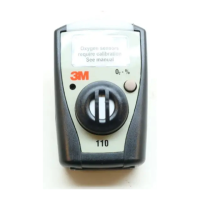CAUTION
This instrument contains a lithium battery. Dispose of in accordance with local regulations.
Avoid the use of harsh cleaning materials, abrasives and other organic solvents. Such materials may
permanently scratch the surfaces and damage the display window, labels, or instrument housing.
USE INSTRUCTIONS AND LIMITATIONS
IMPORTANT: Before use, each person using this equipment must read and understand these User
Instructions. Keep these User Instructions for reference.
Use For
Monitoring for, either Carbon Monoxide (CO), Hydrogen Sulfide (H
2
S) or Oxygen (O
2
).
Do Not Use For
Monitoring for gases other than those which the instrument was designed to monitor, or in atmospheres
where oxygen concentrations are below 12% when equipped with Carbon monoxide (CO) or Hydrogen Sulfide
(H
2
S) sensors. Prolonged exposure to high levels of target gas may prematurely degrade sensor performance.
General Description
These User Instructions apply to the 3M
™
Single Gas Monitor 110 Series. It is designed to provide continuous
monitoring of the ambient environment for Carbon Monoxide (CO), Hydrogen Sulfide (H
2
S) or Oxygen (O
2
),
depending on which sensor is installed in the instrument. The gas detected by the sensor installed in the
instrument is identified on the label located on the front of the unit and the sensor symbol on the LCD
display. Accuracy of the instrument’s gas sensor readings can vary up to +25% depending on the accuracy
of the calibration gas, how often a calibration (O
2
) or calibration verification test (CO, H
2
S) is performed,
environmental conditions (temperature, atmospheric pressure, humidity, air velocity), cross interference gases
or time of exposure to the target gas (see SPECIFICATIONS section). Calibrating (O
2
) prior to use in the same
environmental conditions as the instrument will be used will increase the accuracy of the instrument’s gas
concentration reading (see Calibration Verification Test and Calibration section). An internal microprocessor
controls the indication and alarm functions in response to the signals received from an electrochemical sensor
permanently mounted inside the unit. When turned on, it continuously monitors the ambient air that enters
the sensor through the sensor inlet opening by the process of passive diffusion. If the level of the target gas
detected by the sensor reaches a factory preset alarm point, the unit will alarm (see SPECIFICATIONS section).
The 110 monitor is a battery powered unit utilizing a permanently mounted, non-rechargeable 3.6-volt Lithium
battery. It is designed to be intrinsically safe. The 110 monitor is CSA (US) certified intrinsically safe for Class
I, Div. I, Groups A, B, C, and D Hazardous Locations.
The components of the 110 monitor are assembled in an ABS/PC plastic housing 3.2 x 2 x 1.2 in. (8.1 x 5.1
x 3.1 cm). Located on the front face of the unit is an ON/MENU button, the display (LCD), sensor inlet, audio
alarm opening, visual alarm LED. On the back of the instrument is an alligator pocket/belt clip and a label
containing the intrinsic safety information and serial number.
Fig. 1
SPECIFICATIONS
Size 3.2 x 2.0 x 1.2 in. (8.1 x 5.1 x 3.1 cm)
Weight 4.1 oz. (115 g)
Ingress Protection
Rating
IP54
Sensor Electrochemical
Operating Humidity 15 – 90% (non-condensing)
Readout Direct read LCD
Range 0-995 ppm (CO)
0-200 ppm (H
2
S)
0-25% v/v (O
2
)
Alarm Indicators Visual: Flashing LCD display and Red LED
Audio: 85 dBA @ 1 foot (30.5 cm) buzzer
Tactile: Internal vibrator
Alarm Readings Low, High Alarms, Low Battery, Over Range
Alarm Settings See alarm settings in the table below
Reading Resolution 5 ppm – Carbon Monoxide (Reading start at 20 ppm or greater)
5 ppm – Hydrogen Sulfide (Reading start at 10 ppm or greater)
0.5% v/v -Oxygen (Increments from 21.0%)
Test Function Self-test on circuitry, battery and alarms.
Operating Life 2 years from activation (maximum 36.5 alarm hours – 3 minutes/day)

